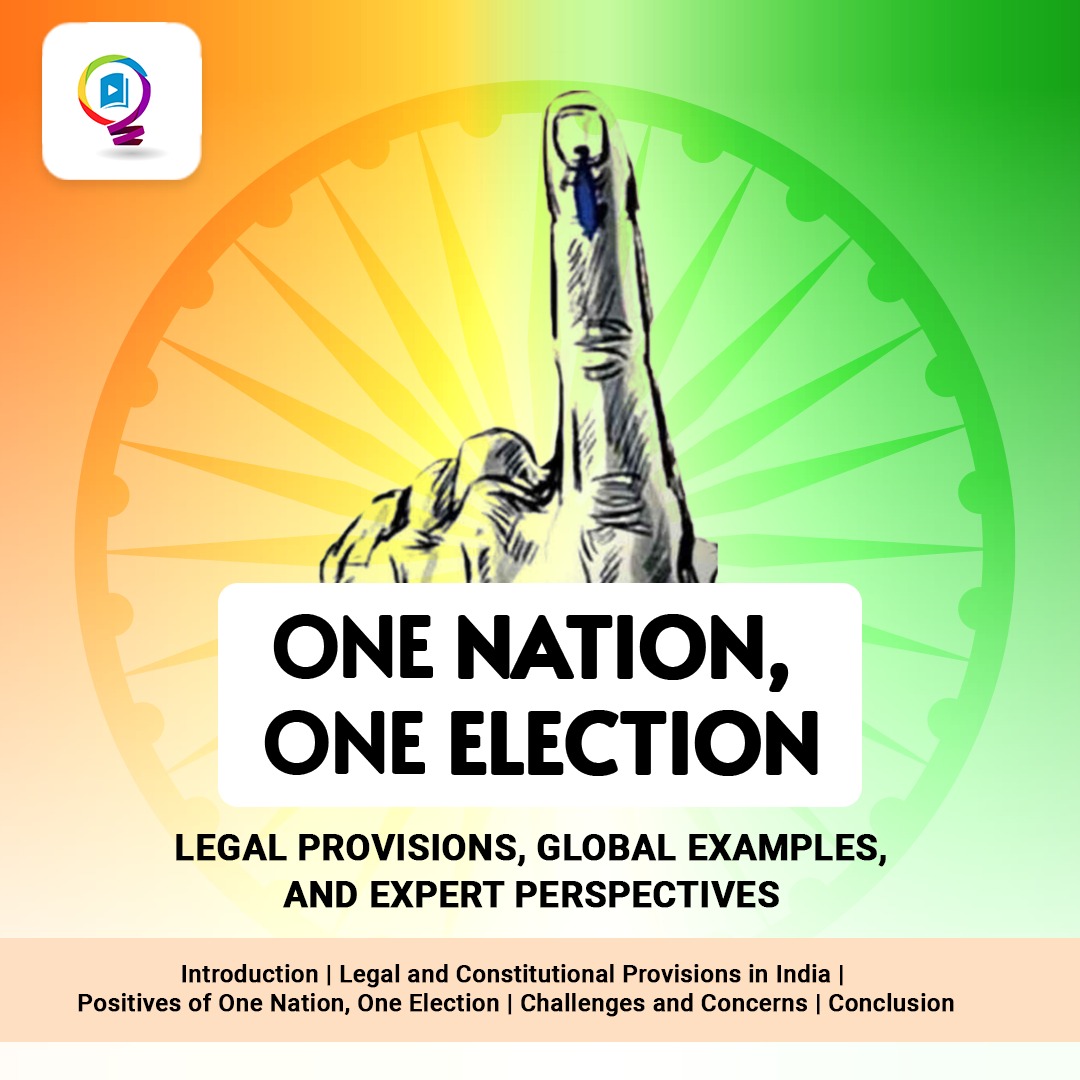CURRENT AFFAIRS
Get the most updated and recent current affair content on Padhaikaro.com
"One Nation, One Election" in India: Legal Provisions, Global Examples, and Expert Perspectives
- Integrity Education, Delhi
- 19, Sep 2023

Introduction
The "One Nation, One Election" (ONOE) proposal has ignited debates and discussions within India's political and legal circles. This concept advocates the synchronization of elections across various tiers of government, including the Lok Sabha, state assemblies, municipalities, and panchayats. Recently, the Indian government formed an 8-member committee, chaired by former President Shri Ram Nath Kovind, to examine and provide recommendations on this matter. In this comprehensive article, we will delve into the legal and constitutional aspects of ONOE, examine its potential merits and challenges within the Indian context, and explore how this concept has been implemented elsewhere in the world.
Legal and Constitutional Provisions in India
- Constitutional Framework: The Constitution of India clearly outlines the need for regular elections for the Lok Sabha (Article 83) and state legislatures (Article 172). It also mandates elections for municipalities (Article 243U) and panchayats (Article 243E).
- Terms of Office: The Constitution prescribes specific terms of office for different legislative bodies. While the Lok Sabha serves a five-year term, state assemblies have varying terms, ranging from five to six years.
- Anti-Defection Law: The Tenth Schedule of the Constitution, commonly known as the Anti-Defection Law, regulates defections by elected representatives. Synchronizing elections could potentially lead to issues related to defection if a representative resigns or switches parties mid-term.
Positives of One Nation, One Election
- Cost Efficiency: The ONOE concept has the potential to drastically reduce the cost of frequent elections. It would streamline the allocation of resources for elections, allowing for more prudent spending in other vital sectors.
- Stability and Governance Focus: Frequent elections often disrupt governance as leaders shift their focus towards campaigning. ONOE could provide much-needed stability and enable governments to concentrate on policy implementation.
- Enhanced Voter Participation: Continuous elections can lead to voter fatigue. Simultaneous elections might rejuvenate voter participation as citizens would be less burdened by frequent electoral cycles.
- Strengthened Federalism: Synchronizing elections for central and state governments could promote cooperative federalism, leading to better coordination between different tiers of government.
Challenges and Concerns
- Constitutional Amendments: Implementing ONOE necessitates substantial constitutional amendments, including harmonizing the terms of various legislative bodies—a complex and time-consuming process.
- Logistical Complexity: Coordinating elections across the vast and diverse landscape of India presents significant logistical challenges. Meticulous planning, infrastructure development, and robust security arrangements would be essential.
- Dominance of National Issues: Holding simultaneous elections may shift the focus away from local concerns towards national issues, potentially diminishing regional representation.
- Impact on Regional Parties: Smaller regional parties may perceive ONOE as a disadvantage, as they might struggle to compete with larger national parties on a synchronized platform.
- Resource Allocation: Conducting simultaneous elections requires substantial resources and manpower, which could strain the Election Commission and other government agencies.
Global Examples and Expert Perspectives
Several countries have experimented with the idea of synchronizing their elections:
- United States: While not simultaneous, the U.S. holds its presidential and congressional elections every four years. The advantage lies in reducing campaign fatigue and allowing the winning party to focus on governance.
- South Africa: South Africa successfully synchronized its national and provincial elections in 1999. This move was aimed at reducing costs, streamlining administration, and promoting political stability.
Legal luminaries and experts have weighed in on the ONOE concept:
- Fali S. Nariman, Eminent Jurist: "The One Nation, One Election concept is a worthy endeavor, but it must be approached with utmost caution to preserve the principles of federalism and ensure representation at all levels of government."
- Dr. Subhash C. Kashyap, Constitutional Expert: "The synchronization of elections is a complex task that requires meticulous planning. It can lead to better governance but must be balanced with the need for robust federalism."
Conclusion
The "One Nation, One Election" proposal presents a compelling vision for India's electoral system, offering cost efficiency, political stability, and potentially higher voter turnout. However, it faces significant constitutional and logistical hurdles. The recent formation of a committee led by former President Shri Ram Nath Kovind reflects the government's commitment to exploring this concept further.
As India continues to evolve as a democratic powerhouse, it is crucial to carefully consider the ONOE concept, balancing the goals of efficient governance with democratic values and representation. Drawing inspiration from global examples and taking into account the insights of legal luminaries, India can pave the way for a robust and synchronized electoral system that serves the diverse needs of its people while preserving the essence of its federal structure.